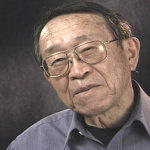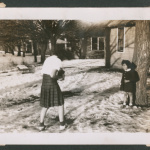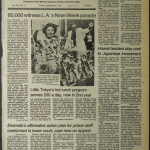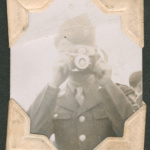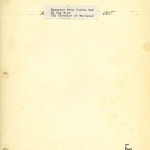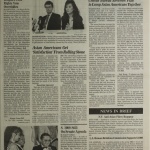Government photography of the WRA Camps and Resettlement
During World War II, the federal government produced thousands of photographs of the forced removal, incarceration, and resettlement of Japanese Americans. A great many of these photographs were produced by the War Relocation Authority's Photographic Section (WRAPS) between 1943 and 1945. These images served largely political purposes, whether to illustrate the "humane" treatment of the excluded or to encourage their " resettlement " outside the West Coast. Whatever their original purpose, their wide availability online has led to their being reused frequently in various media for a variety of purposes.
Overview of WRA Photography
The National Archives holds more than 17,000 negatives of photos taken under the sponsorship of the War Relocation Authority. Over 7,000 images from this corpus are online at JARDA, the University of California's Japanese American Relocation Digital Archive. It is unknown how many of these were taken by the WRAPS, but it is likely that the vast majority of the photos of resettlers taken between 1943 and 1945, while the war was still in progress, were taken by one of six WRAPS-related photographers: Thomas W. Parker , Francis L. Stewart , Charles E. Mace , Hikaru Iwasaki , Gretchen Van Tassel , and Takashi "Bud" Aoyama .
Although complex, the history of the images taken by War Relocation Authority photographers is made easier by a heuristic division into two phases. In Phase One, and as it was coming into existence (1942) the WRA contracted individuals one-by-one to shoot the removal, assembly, and concentration of Japanese Americans following Executive Order 9066 . The orientation during Phase One was to document the round up and the incarceration, perhaps in an effort to demonstrate that although conditions were spartan to say the least, there were no outright human rights abuses such as torture or murder being carried out on the unfortunate prisoners.
Individuals given short-term contracts during this period included Russell Lee , Dorothea Lange , Clement Albers , and Francis Stewart, among others. By the end of 1943, only Stewart still remained on contract.
The War Relocation Authority's "Photographic Section" (WRAPS)
By early 1943, Dillon Myer and the other bureaucrats who directed the WRA decided that their new mission was to wind down the WRA by the end of the war and: (1) segregate the potentially "disloyal" Japanese Americans into the Tule Lake camp; (2) enable eligible second generation men to volunteer for or get drafted in to the U.S. Army; and (3) facilitate the release of "loyal" Japanese Americans back into the larger society while the war was still in progress, if they could pass security evaluations, if they could find a job, and if they would sign an oath to comport themselves as good Americans and avoid contact with ethnic compatriots.
As part of this new orientation that can be called Phase Two, the WRA hired Thomas "Tom" W. Parker, a Colorado-based photographer and career government employee, to head up the newly established WRA Photography Section office, located on one floor in the Midland Savings Building in downtown Denver, Colorado. The original WRAPS team, then, included Parker (head photographer and director), Stewart (staff photographer and the only holdover from Phase One), and Charles Mace (staff photographer and darkroom specialist). Generally speaking, although it could develop its own shoots, WRAPS assignments were directed by John Baker and his staff in the WRA's Reports Division in Washington D.C. which coordinated all requests for photos, generated the final captions for individual shots, wrote and handled PR, as well as information and photos requested by the press, civic organizations, and authors of various sorts.
When, in less than a year, Stewart decided to resign for "personal reasons," Mace became the second staff photographer. After interviewing candidates, Parker decided to hire 19-year-old Hikaru Iwasaki, who had a background in photography, and who had been taking X-rays in the Heart Mountain , Wyoming, camp hospital, to take over the darkroom work. Because of the high volume of work, however, Iwasaki was rapidly promoted to be the third full-time staff photographer, and Parker returned to Heart Mountain to hire Iwasaki's friend, Takashi "Bud" Aoyama as the new darkroom tech. From 1944 to the end of 1945, when WRAPS was shut down, these were the basic personnel of the Section.
Although WRAPS photographers continued to do shoots of the ten more permanent WRA camps, in 1943 they increasingly turned their attention to taking portraits and documenting the stories of "loyal" Japanese Americans who sought release from camp and resettled to points east of the Western Defense Command 's restricted military zones . Shoots were scheduled all over the USA, from the Rocky Mountain states, to the Midwest, to the South, to the eastern seaboard including New England. While the captions that accompanied the resettlement photos vary from being descriptive, to corny, to propagandistic the portraits themselves constitute a valuable record of "The Salvage": that is, the Japanese Americans who were considered loyal, and who were able to win release from the WRA camps while the war was still in progress.
Nonetheless, there are serious critiques of the WRAPS photographs that have been leveled by the Japanese American community. Among complaints are the fact that the WRAPS photos of resettlers seem artificial, posed (as in too many people smiling), reinforce stereotypic gender and familial roles, don't show poor living/employment conditions, or anti-Japanese violence visited upon resettlers, etc. There is validity to each of these points, although it seems most appropriate to determine if they apply to individual photos rather than to characterize the WRAPS corpus as a whole. Even so, with the passing of generations, and the reconfiguration of both the camp site areas as well as the points of resettlement, if and when re-captioned for other purposes, the WRA and WRAPS photos' value will only increase over the years. (As evidence of this point, one need only look at the utility of official WRA photographs in terms of illustrating a project such as this on-line encyclopedia of Japanese Americans during World War II. Just because the original captions are propagandistic, that is, there is no reason that the photos themselves can't be fitted with new narratives that are either more accurate, or that better serve historically-heuristic purposes.)
Other Photography of the Incarceration
Perhaps it is useful to end this entry by pointing out that there were a plethora of World War II photos of the camps and resettlers that were not taken by Phase One or Phase Two WRA photographers. Although she was in charge of handling the WRAPS photos in the Reports Office in Washington D.C., for example, executive secretary Gretchen Van Tassel also went out on photo shoot assignments when it was more convenient for her to get to a site on the east coast or in the mid-West. Individual camp "reports officers" such as Pauline Bates Brown in Poston , or Joe McClelland in Amache have official WRA photos on the record. Major newspapers, and on occasion magazines, sent their staff photographers to shoot images for stories and features. On occasion, photographers with the Army Signal Corps sometimes took photos of WRA operations and personnel. There were independent photographers like Ansel Adams who did an extensive photographic shoot at the Manzanar camp. There were also a number of Japanese American photographers who were hired or allowed by camp directors to shoot pictures but who were not on the official WRA payroll as WRA photographers or staff working under WRAPS supervision: e.g., Toyo Miyatake , an Issei , and Stone Ishimaru, a Nisei . Finally, there were a few persons who gained access to a camera who shot many photos on their own: Nisei Bill Manbo, who was confined in the camp at Heart Mountain , would be a good example of this category of photographer.
The point here is that, in each of the above cited cases, we need to know more about each of the above types as well as the specifics of each camera person. Clearly, their conditions of employment, their positionality, their aims, as well as the conditions and constraints they faced on a given shoot, have much to do with what images they produced, and the possible strengths and weaknesses (i.e., biases) that viewers or users should keep in mind as they cite or use their photographs.
For More Information
Alinder, Jasmine. Moving Images: Photography and the Japanese American Incarceration . Chicago and Urbana: The University of Illinois Press, 2009.
Creef, Elena Tajima. Imaging Japanese America: The Visual Construction of Citizenship, Nation and the Body . New York: New York University Press, 2004.
Hirabayashi, Lane Ryo, with Kenichiro Shimada. Japanese American Resettlement Through the Lens: Hikaru Carl Iwasaki and the WRA's Photographic Section, 1943–1945 . Photographs by Hikaru Carl Iwasaki. Foreword by Norman Y. Mineta. Boulder: University Press of Colorado, 2009.
Japanese American Relocation Digital Archives (JARDA). https://calisphere.org/exhibitions/t11/jarda/
Manbo, Bill T., and Eric Muller L. Colors of Confinement: Rare Kodachrome Photographs of Japanese American Incarceration in World War II . Chapel Hill: University of North Carolina Press, 2012.
Matsumoto, Nancy. "Reclaiming Photographs of WWII Japanese-American Resettlement." Discover Nikkei website. http://www.discovernikkei.org/en/journal/2009/11/16/reclaiming-photographs/ .
Last updated Jan. 18, 2024, 4:52 p.m..

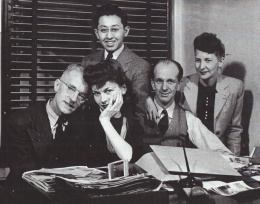 Media
Media
